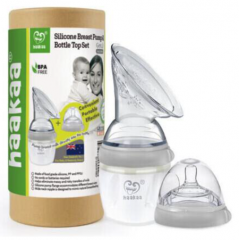Your Baby's First Foods Eat Suitable for stages: 3 - 6 Months, 6 - 12 Months
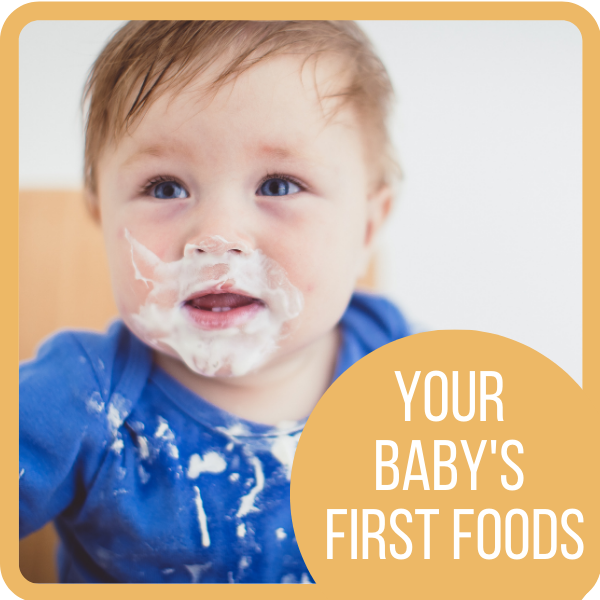

The introduction of first foods is the start of a gradual move from a milk-based diet to a varied diet of family foods. Breastmilk (and formula) is a complete food designed for your baby at the time that they need it, so it will remain their main source of nutrients and hydration at least until they are around 12 months old.
It will be entirely up to you and your baby when the right time is to start on the first foods; however, it is recommended not to start before 4 months. A common belief of parents of babies around the 4-month mark (when they experience their sleep regression), is that introducing foods early will lead to their baby sleeping better at night. This is a reasonable thing to think. However, there is no evidence to support that introducing foods results in any improvement; it will likely not affect or may even make sleep worse due to stomach discomfort. There is also some evidence that weaning at or before 4 months is associated with a "30% higher risk of being overweight or obese in childhood, and a less diverse gut microbiome". However, if the baby was breastfed beyond 4 months, they "did not have a higher BMI at 5 years" - indicating that breastfeeding is a protective factor.
The WHO recommendation is to start solids from 6 months. Babies may start to show an interest in food from around 4 months; however there are certain skills and developmental milestones which help your baby to engage with learning about first foods:
- Their digestive system matures to begin to become ready for first foods - nappies will be distinctly different.
- Your baby starts to lose the extrusion reflex (where they will push food or anything in their mouth back out of their mouth with their tongues)
- Your baby can maintain a sitting up posture unaided with good head and neck control.
- Your baby can reach and grab intentionally and bring items to their mouth.
- Your baby is showing an interest in what you are eating and may even start to grab for your food or ask for your food
- Although your baby can start solids before they have teeth, their first two teeth do start to emerge on average between 6 to 10 months old. As their teeth emerge, this helps with learning how to chew new foods. The teething process can also affect your baby's acceptance of foods at different times.

It is commonly recommended to offer milk before first foods until around 8 months to ensure baby is not too hungry when trying foods, after this time it is not as important whether food or milk is offered first. The saying and mantra to remind yourself is, "Until 1, food is for fun".
Apart from iron-rich foods, the first foods are more about sensory and motor learning experience than for the purpose of providing nutrition.
6 months is around the time that the stores of iron that your baby received at birth starts to run out, causing a drop in iron levels. It is believed that the amount of iron your baby needs can’t be provided by breastmilk or formula alone, so introducing iron-rich foods is commonly recommended.
When you hear about your baby needing food for their low stores of iron, it is easy to get worried and uptight about getting food into your baby. Of course, if you are worried about low iron, get familiar with the signs of low iron and look out for them. If you have any concerns, see your doctor. Otherwise, the most important part of introducing your baby to foods is to make it social, encourage exploration and sensory learning and make it fun.
Involving baby in family meals is important for learning about the social aspect of eating and experiencing the taste and texture of family foods whilst watching how the family eat. This is a great time to move to more nourishing foods for all the family so that there is no the pressure of having different foods for baby and to give you the flexibility to share your meals with your baby.
If you are stressed about the food, then your baby will pick up on this and follow your lead. The most effective approach is to be relaxed, avoid the urge to be controlling, be supportive, fun and flexible. If you have gone to a lot of effort to make the food, and are worried about waste, be prepared to eat it yourself. In fact, one way to pique your baby's interest in food, is to start eating the food yourself, then if they show an interest, or start to reach for it, then offer them their own portion or taste on a spoon. If you want to ideas for how to make food fun, you can listen to the podcast "How to Make Food Fun" - with Adam Liaw and Maggie Dent
It is important to be responsive to your baby’s body language when interacting with food and ensure you are letting your baby guide texture choice and how much food they eat. By watching your baby and learning their communication and body language around food, you will learn their signals for more and finished. Signs that they want more are usually pretty easy to interpret - reaching for the food/spoon to bring the food to their mouth, leaning in, nodding their head, and they are generally happy. Signs that they have had enough might include turning their head away from the food, becoming disinterested or distracted, throwing the food on the floor instead of bringing it to their mouth, or pushing the food or the spoon away. This may mean they don’t want what you have offered them but will accept something different, it means they aren’t hungry or are getting tired and want to do something else.
From around 10 months, your baby will go through a development leap where they can start to communicate either verbally or gesture or both when they want more or have had enough. As early as possible, it's a great idea to introduce the use of simple sign language at meal times. If you consistently use the baby signs, as soon as your baby is ready to communicate back, they have a simple way to communicate their food needs back to you such as signing for 'milk', 'eat', 'more' and 'finished'. There can be significant frustration at meal times before your baby is able to verbally communicate and this approach can help to bridge the communication gaps.
Choosing first foods
If you do start to offer foods before your baby is 6 months, your best choices would be to offer plain fruit or sweeter vegetable-based purees and spoon feed these to your baby. It is at around 6 months that they start to reach for objects with their whole hand, and by grabbing with all their fingers and thumb in one action, they can pick up objects and can also transfer objects between their hands. These new hand skills are perfect for trying out with foods by following the baby-led weaning approach. You can choose softened fingers of food such as carrots or brocolli florets that they can grab with their hands and bring to their mouths.
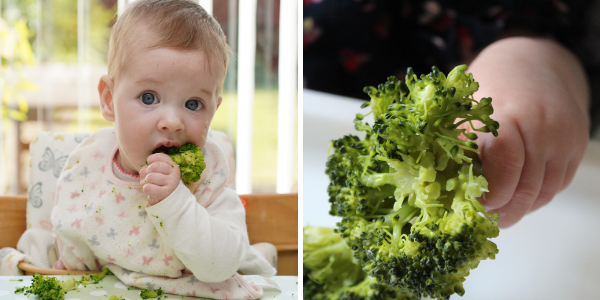
By 9 months they might be starting to bring their thumb and top half of their forefinger together in an immature pincer grasp to pick up small objects. They may also be pushing objects with their forefinger. At the same time, all their practise with using their tongue and their mouth to move food around their mouth and the emergence of a few teeth, all combine to help them advance in their feeding skills. Meal times are a great time to practise these new hand and eating skills by providing smaller sized foods such as diced sweet potato, peas or corn.
Where you can afford to, buy certified organic foods (follow the link to the Better Health Channel website to find out why). Some foods that are commonly grown using pesticides are more important to buy organic, others are less important to buy organic - here is an example of a Clean Fifteen and Dirty Dozen Foods List for Australian foods.
Babies naturally prefer sweet tastes and start off with an aversion to bitter tastes. It could be worth introducing less sweet vegetables such as zucchini, eggplant, beans, spinach, broccoli and mushrooms before or with the sweeter vegetables such as sweet potato, carrots, peas and corn so that your baby can develop a wider range of food preferences. Also, offering foods separately rather than mixing different foods together such as in commercial baby foods could help your baby to learn about the different tastes and influence future acceptance of these foods.
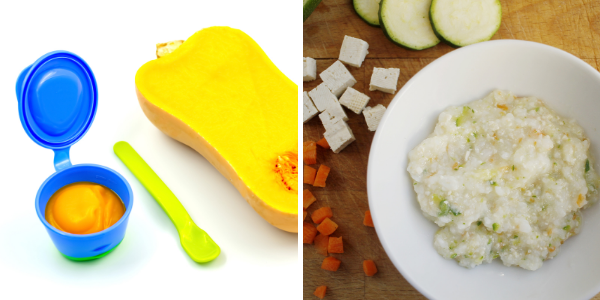
Good choices are iron-rich foods such as infant cereals, red meat, chicken, fish, tofu, legumes and leafy greens. Try to increase the types of nutrient-dense foods into your baby's diet over time with the exception of honey until your baby is over 12 months old due to the risk of botulism.
For any new foods, offering them early in the day can help you to monitor any adverse food reactions. Also, when introducing commonly allergenic foods to your baby such as wheat, dairy, eggs, nuts, soy, sesame, taking a slow/staged approach can allow you to monitor your baby for any reactions before introducing the next food. If you or your partner have food sensitivities or allergies, these will be the foods to watch when you introduce these to your baby. The latest recommendation is to introduce allergenic foods from 6 months, preferably while breastfeeding, to reduce the likelihood of allergy development.
There are many reasons why your baby can be fussy with food textures, tastes, and temperatures. Sometimes, food refusal is just to do with what is happening with your baby's development, health or appetite on that day, but for some kids, it is an indication of some larger health condition/s. Fussy eating can be linked with tongue-tie, inflammation of the tonsils and/or adenoids, teeth and gum problems, gut issues, or sensory sensitivities. If you feel like something is not right, it is worth getting a medical professional to have a look. Allowing your baby to fully explore their foods with a sensory goal, can encourage them away from fussy eating and towards trying new foods.
Choking vs Gagging and food safety
When your baby is first learning how to eat, it is quite normal for them to gag on the food (bring the food from the back of their mouth to the front with a cough like sound). Once the food is back to the front of their mouth, they will either keep chewing it or spit it out. At first, you might think they are choking, but the sound is distinctively different.
To prevent actual choking incidents, it is important to take some precautions with certain foods, supervise them closely anytime they are eating (so you can respond quickly if needed), and encourage them to sit down to eat rather than moving/walking around. If your baby did choke, make sure you know what to do by learning how to respond to a choking incident or attending a course on baby first aid. There are common foods that can cause choking, but they can easily be prepared to reduce the chance of choking.
Examples include:
- whole grapes/olives/berries/cherry tomatoes - cut in half and de-seed
- apples - chopped into very small pea-sized pieces or steam to soften
- hard raw vegetables such as carrots - grate or shred
- raw whole nuts - chop or blend
- popcorn - is difficult for babies and toddlers to eat and probably should be avoided
- chunks of meat/sausages - cut up into small pieces or make sure they are very tender
- sticky foods such as cheese, thick peanut butter and marshmallows - limit quantities or chop small until you know your child can manage them.
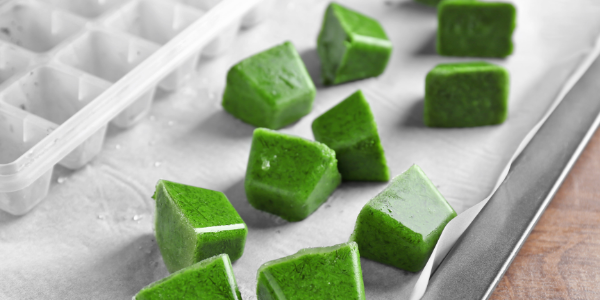
All the food safety rules you followed during your pregnancy to avoid food poisoning will naturally apply when preparing foods for your baby. When making purees, there is usually a lot left over after your baby tries a small amount or doesn't try much of your cooking. To avoid waste (and disappointment), try using a freezer tray or small containers to freeze the leftovers. When it is frozen, place in a zip lock back or container and keep in the freezer to defrost as needed.
When serving hot foods or drinks, make sure you test the temperature before offering it to your baby. Microwaves are known for unevenly heating foods, which can mean the food can range in temperature from cold or lukewarm to boiling hot. It can also be tempting to heat food up in plastic containers or bowls in the microwave, which is not recommended due to the risk of chemical breakdown of the plastic into the food. Heating food up on the stove or oven preserves the nutrients in the food, and the temperature is more consistent.
So there are some things to know before you start solids with your baby, but once you have the hang of it, it can be fun and social. As your baby develops confidence and independence, there will gradually be less mess to clean up and you can continue to have meals together as a family.
Please note: Above all, any information on this website aims to provide general ideas for informational and educational purposes only. We encourage users to investigate several information sources, including, where necessary, independent individualised medical advice before making any decisions that could affect you or your child’s health or wellbeing.
BabyPeg participates in various affiliate programs and may earn a commission for referring our users through the links provided. This is at no additional cost to our users. We take great care in choosing products and services which align with the mission of promoting better health and wellness for our BabyPeg community. Where possible, products are tried and tested by us. To continue to provide BabyPeg as a free service and reach as many parents as possible, we appreciate your support in using the link provided to purchase if you decide the product is right for you.


